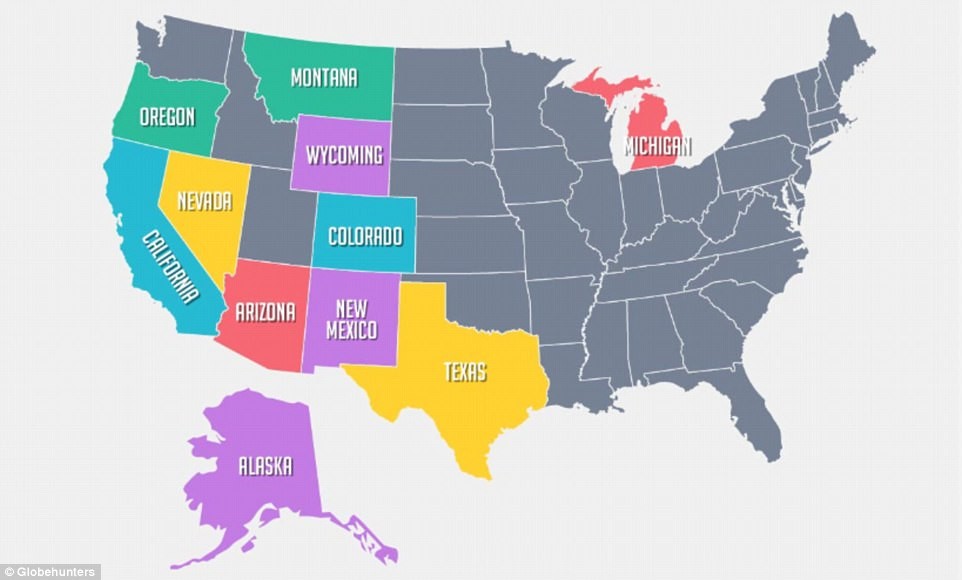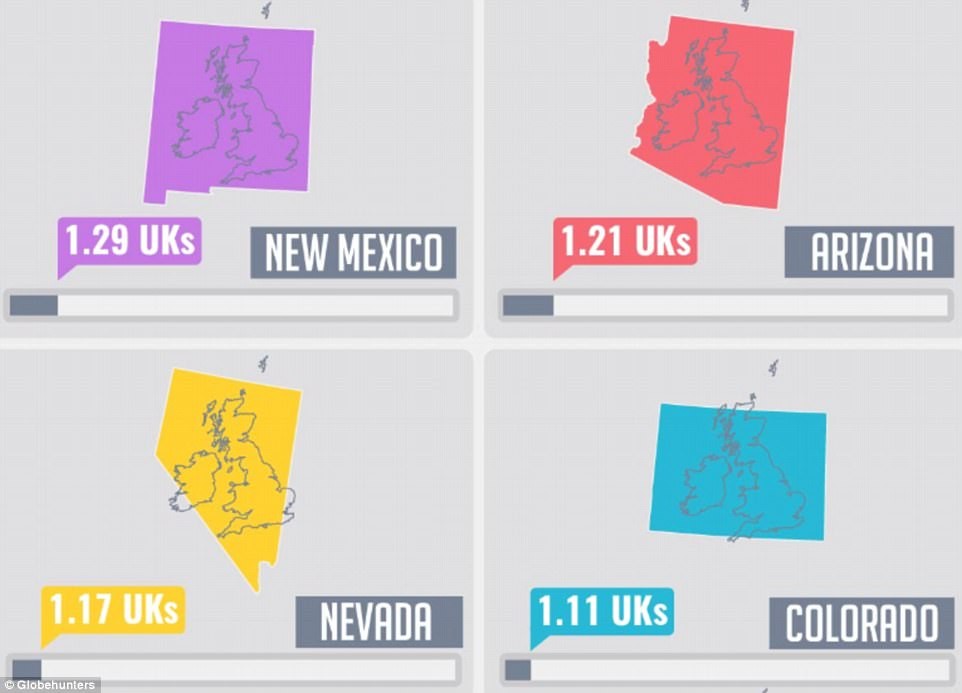England’s size compared to a US state reveals interesting geographical facts and helps visualize relative land areas. COMPARE.EDU.VN offers insightful comparisons, making it easier to understand the scope and scale differences between countries and states, enhancing your understanding of global geography, regional dimensions, and spatial analysis. Delve into geographical comparisons now.
1. How Does the Size of England Compare to US States?
England is significantly smaller than many US states. While England covers approximately 50,346 square miles (130,395 square kilometers), several US states dwarf it in size. This comparison highlights the vastness of the United States and provides a tangible perspective on geographical dimensions.
1.1. England vs. US States: A Detailed Comparison
To provide a clear understanding, here’s a comparison of England’s size with several US states:
| US State | Area (Square Miles) | Multiple of England |
|---|---|---|
| Alaska | 665,384 | 13.22 |
| Texas | 268,596 | 5.33 |
| California | 163,696 | 3.25 |
| Montana | 147,040 | 2.92 |
| New Mexico | 121,590 | 2.41 |
| Arizona | 113,990 | 2.26 |
| Nevada | 110,572 | 2.19 |
| Colorado | 104,094 | 2.07 |
| Oregon | 98,379 | 1.95 |
| Wyoming | 97,814 | 1.94 |
| Michigan | 96,716 | 1.92 |
| Minnesota | 86,936 | 1.73 |
| Utah | 84,899 | 1.68 |
| Idaho | 83,569 | 1.66 |
| Kansas | 82,278 | 1.63 |
| Nebraska | 77,354 | 1.54 |
| South Dakota | 77,116 | 1.53 |
| Washington | 71,362 | 1.42 |
| North Dakota | 70,698 | 1.40 |
| Oklahoma | 69,899 | 1.39 |
| Missouri | 69,707 | 1.38 |
| Florida | 65,758 | 1.30 |
| Wisconsin | 65,496 | 1.30 |
| Georgia | 59,425 | 1.18 |
| Illinois | 57,914 | 1.15 |
| Iowa | 56,273 | 1.12 |
| New York | 54,555 | 1.08 |
| North Carolina | 53,819 | 1.07 |
| Arkansas | 53,179 | 1.06 |
| Alabama | 52,420 | 1.04 |
| Mississippi | 48,430 | 0.96 |
| Pennsylvania | 46,054 | 0.91 |


As the table shows, many US states are significantly larger than England. Even states like New York, North Carolina, Arkansas, and Alabama are comparable in size, while others like Alaska and Texas are many times larger. This scale difference underscores the expansive geography of the United States.
2. Which US States Are Larger Than England?
Many US states are larger than England. To put it into perspective, here are some of the most notable ones:
- Alaska: As the largest state in the US, Alaska is more than 13 times the size of England.
- Texas: Known for its vast landscapes, Texas is over 5 times larger than England.
- California: Famous for its diverse geography, California is more than 3 times the size of England.
- Montana: With its stunning mountain ranges and open spaces, Montana is almost 3 times larger than England.
- New Mexico: Known for its unique desert landscapes, New Mexico is more than 2 times larger than England.
- Arizona: Famous for the Grand Canyon, Arizona is also more than 2 times larger than England.
- Nevada: Primarily desert, Nevada is also more than 2 times larger than England.
- Colorado: Famous for the Rocky Mountains, Colorado is also more than 2 times larger than England.
- Oregon: Known for its forests and coastline, Oregon is almost 2 times larger than England.
- Wyoming: Home to Yellowstone National Park, Wyoming is also almost 2 times larger than England.
- Michigan: Michigan is almost 2 times larger than England.
2.1. Visualizing the Size Difference
To truly grasp the size difference, imagine overlaying England onto a map of these US states. England would appear as a small region within each of these states, emphasizing the vastness of the American landscape.
3. Why Is Understanding Geographical Size Important?
Understanding geographical size is crucial for several reasons:
- Resource Management: Knowing the size of a region helps in planning resource allocation and infrastructure development.
- Environmental Studies: Size influences climate, ecosystems, and the impact of environmental changes.
- Economic Planning: Geographical dimensions affect trade, transportation, and market opportunities.
- Political Strategy: Size can influence political power and strategic planning.
- Cultural Understanding: Geographical context shapes cultural practices and regional identities.
3.1. How Geographical Size Impacts Daily Life
The size of a region can significantly impact daily life. Larger areas may have:
- Longer commutes
- Varied climates within the same region
- Greater distances between cities and towns
- Different regional cultures and identities
Understanding these impacts can help in making informed decisions about living, working, and traveling.
4. Factors Contributing to the Size Difference
Several factors contribute to the significant size difference between England and many US states:
- Historical Development: The US expanded through territorial acquisition and settlement, leading to vast land areas.
- Geographical Features: The US has diverse geographical features, including deserts, mountains, and plains, contributing to its overall size.
- Political Structure: The US is a federal republic comprising 50 states, each with its own governance and territory.
- Population Distribution: The population density varies across the US, with large areas of sparsely populated land.
4.1. The Role of Historical Expansion
The historical expansion of the United States through purchases, treaties, and conquests significantly increased its land area. This expansion played a crucial role in shaping the geographical landscape we see today.
5. Comparing England to Individual Regions of US States
While comparing England to entire US states provides a broad perspective, it can also be insightful to compare it to specific regions within those states:
- England vs. Southern California: Southern California, with its diverse economy and large population, offers a comparable regional perspective.
- England vs. Central Texas: Central Texas, known for its rapid growth and vibrant culture, provides another interesting comparison.
- England vs. the Arizona Desert: The vast Arizona Desert showcases the stark contrast in landscapes and ecosystems.
5.1. Case Study: England vs. Southern California
Southern California, encompassing major cities like Los Angeles and San Diego, has a diverse economy and a large population. Comparing it to England can highlight similarities and differences in urban development, economic activity, and cultural influences.
6. Population and Density: A Different Perspective
While England is smaller in area, it has a higher population density compared to many US states. This contrast highlights the difference between size and population distribution.
- England: High population density, concentrated urban areas.
- US States (e.g., Montana, Wyoming): Low population density, vast rural areas.
6.1. Impact of Population Density on Resources
Higher population density in England means greater demand for resources like water, energy, and housing. In contrast, lower population density in states like Montana and Wyoming allows for more extensive resource availability per capita.
7. Economic Comparisons: England vs. US States
Comparing the economies of England and individual US states offers insights into their economic strengths and weaknesses.
- England: Diverse economy with strengths in finance, manufacturing, and services.
- Texas: Strong economy driven by oil, technology, and agriculture.
- California: Leading economy in technology, entertainment, and agriculture.
7.1. GDP Comparison
A comparison of GDP (Gross Domestic Product) provides a quantitative measure of economic output:
| Region/State | GDP (USD Billion) |
|---|---|
| England | 3.3 Trillion |
| California | 3.6 Trillion |
| Texas | 2.0 Trillion |
This comparison illustrates the economic power of both England and leading US states like California and Texas.
8. Cultural Comparisons: England vs. US States
Cultural differences and similarities between England and US states are shaped by history, demographics, and regional influences.
- England: Rich history, traditional customs, diverse cultural influences.
- Texas: Blend of Southern, Western, and Hispanic cultures.
- California: Diverse mix of cultures from around the world.
8.1. Influence of Regional Identities
Regional identities play a significant role in shaping cultural practices and values. For example, the Southern culture in Texas differs significantly from the coastal culture in California, just as regional variations exist within England.
9. Environmental Considerations: England vs. US States
Environmental factors such as climate, ecosystems, and natural resources vary significantly between England and individual US states.
- England: Temperate climate, diverse landscapes.
- Arizona: Arid climate, desert ecosystems.
- California: Mediterranean climate, diverse ecosystems.
9.1. Climate Change Impacts
Climate change impacts are felt differently in England and various US states. Coastal regions face rising sea levels, while arid regions experience increased drought. Understanding these differences is crucial for effective environmental management.
10. What Are the Implications of Size Differences for Travel and Tourism?
The size difference between England and US states has significant implications for travel and tourism.
- England: Compact, easy to navigate, rich in historical sites.
- Texas: Vast distances, diverse landscapes, road trip destinations.
- California: Diverse attractions, from beaches to mountains, requiring extensive travel.
10.1. Planning a Trip: England vs. Texas
Planning a trip to England involves navigating a relatively small area with numerous historical sites and cultural attractions. In contrast, planning a trip to Texas requires considering vast distances, diverse landscapes, and a variety of activities, from visiting cities to exploring national parks.
11. How Does the UK Compare to Other US States?
The UK, comprising England, Scotland, Wales, and Northern Ireland, covers approximately 93,628 square miles. Comparing the UK to US states provides a broader perspective on geographical dimensions.
- UK vs. Oregon: Oregon is slightly larger than the UK.
- UK vs. Wyoming: Wyoming is also slightly larger than the UK.
- UK vs. Michigan: Michigan is almost the same size as the UK.
11.1. The UK vs. the Eastern Seaboard
The Eastern Seaboard of the US, encompassing states like New York, Pennsylvania, and Massachusetts, offers a diverse range of landscapes and urban centers. The UK’s size is comparable to this entire region, highlighting the density and diversity within a relatively small area.
12. Education and Research: Insights from Universities
Universities conduct research on geographical comparisons, providing valuable insights into regional dynamics.
- University of Oxford: Studies on urban development and regional planning in England.
- University of Texas at Austin: Research on the economic and cultural impact of Texas’s size.
- University of California, Berkeley: Analysis of environmental changes and resource management in California.
12.1. Academic Perspectives on Size and Development
Academic research emphasizes the importance of understanding geographical size in the context of economic development, environmental sustainability, and cultural preservation.
13. Practical Applications: Using Size Comparisons in Real Life
Understanding size comparisons has several practical applications in real life.
- Travel Planning: Estimating travel times and distances.
- Real Estate: Assessing property values based on location and size.
- Business Planning: Identifying market opportunities based on regional demographics.
- Environmental Conservation: Managing resources and protecting ecosystems.
13.1. Case Study: Planning a Cross-Country Move
Planning a move from England to a US state like Texas requires considering the vast differences in size, climate, and culture. Understanding these differences is crucial for making informed decisions about housing, employment, and lifestyle.
14. What Are the Key Takeaways From These Size Comparisons?
The key takeaways from these size comparisons include:
- The United States is geographically vast, with many states significantly larger than England.
- Understanding geographical size is crucial for resource management, economic planning, and environmental conservation.
- Population density varies significantly between England and US states, impacting resource demand and lifestyle.
- Cultural and economic differences are shaped by regional identities and historical factors.
14.1. Implications for Global Understanding
Understanding these size comparisons enhances global understanding by providing a tangible perspective on geographical dimensions and regional dynamics.
15. How Can COMPARE.EDU.VN Help You Make Informed Decisions?
COMPARE.EDU.VN offers detailed comparisons of various geographical regions, economic indicators, and cultural factors, helping you make informed decisions about travel, business, and personal development.
15.1. Features and Benefits of Using COMPARE.EDU.VN
- Detailed geographical comparisons
- Economic analysis and data
- Cultural insights and regional profiles
- User-friendly interface
- Regularly updated information
COMPARE.EDU.VN empowers you to explore and understand the world around you, making informed decisions based on accurate and comprehensive data.
16. Expert Opinions on Geographical Size
Experts in geography and regional planning emphasize the importance of understanding size comparisons in various contexts.
- Dr. Emily Carter, Geographer: “Size influences everything from climate to culture. Understanding these differences is crucial for effective planning and development.”
- Professor John Davis, Urban Planner: “Population density and resource availability are directly linked to geographical size. Planners must consider these factors when designing sustainable communities.”
- Sarah Johnson, Environmental Scientist: “Ecosystems and climate change impacts vary significantly based on geographical location. Understanding these differences is essential for conservation efforts.”
16.1. Insights From Leading Geographers
Leading geographers highlight the importance of studying geographical size in the context of global challenges such as climate change, urbanization, and resource management.
17. Future Trends in Geographical Studies
Future trends in geographical studies include:
- Increased use of GIS (Geographic Information Systems) for data analysis
- Focus on sustainable development and environmental conservation
- Integration of cultural and economic factors in regional planning
- Emphasis on global understanding and intercultural communication
17.1. The Role of Technology in Geographical Analysis
Technology plays a crucial role in geographical analysis, enabling researchers to collect, analyze, and visualize data in innovative ways. GIS, remote sensing, and data analytics are essential tools for understanding regional dynamics and global trends.
18. How to Use Geographical Knowledge in Everyday Life
You can use geographical knowledge in various aspects of everyday life:
- Travel: Planning trips and understanding regional differences.
- Business: Identifying market opportunities and assessing risks.
- Education: Enhancing your understanding of global events and cultural diversity.
- Community Involvement: Contributing to local planning and conservation efforts.
18.1. Practical Tips for Applying Geographical Insights
- Use maps and GIS tools to explore different regions.
- Read books and articles about geography and regional studies.
- Attend lectures and workshops on geographical topics.
- Engage in community planning and conservation activities.
19. What Are the Common Misconceptions About Geographical Size?
Common misconceptions about geographical size include:
- Size equates to importance: Larger regions are not necessarily more important than smaller ones.
- Population density is uniform: Population is not evenly distributed across all regions.
- Climate is consistent across a region: Climate can vary significantly within a large area.
19.1. Debunking Myths About Geographical Dimensions
It is essential to debunk these myths and understand the complexities of geographical dimensions. Size is just one factor among many that shape the character and dynamics of a region.
20. FAQs About Comparing England to US States
20.1. How much bigger is Texas than England?
Texas is approximately 5.3 times larger than England.
20.2. Is California bigger than England?
Yes, California is approximately 3.25 times larger than England.
20.3. Which US state is closest in size to England?
Alabama is the closest in size to England.
20.4. What is the population density of England compared to Texas?
England has a much higher population density compared to Texas.
20.5. How does the economy of California compare to that of England?
The economy of California is comparable to that of England.
20.6. What are the main cultural differences between England and Texas?
Cultural differences include regional identities, historical influences, and social norms.
20.7. How does climate change impact England and California differently?
England faces rising sea levels, while California experiences increased drought.
20.8. What are the best tourist destinations in England and Texas?
England offers historical sites, while Texas provides diverse landscapes and road trip destinations.
20.9. How can geographical knowledge help in business planning?
Geographical knowledge helps in identifying market opportunities and assessing risks.
20.10. What are the future trends in geographical studies?
Future trends include increased use of GIS, sustainable development, and global understanding.
21. Conclusion: The Significance of Size in Geographical Comparisons
Understanding the size difference between England and US states provides valuable insights into geography, economics, culture, and environmental factors. These comparisons enhance global understanding and inform decision-making in various aspects of life.
21.1. Final Thoughts on Exploring Geographical Dimensions
Exploring geographical dimensions opens up new perspectives on the world and fosters a deeper appreciation for the diversity and complexity of our planet. By leveraging resources like COMPARE.EDU.VN, you can continue to expand your knowledge and make informed decisions about travel, business, and personal development.
Ready to explore more geographical comparisons and make informed decisions? Visit compare.edu.vn today at 333 Comparison Plaza, Choice City, CA 90210, United States, or contact us via WhatsApp at +1 (626) 555-9090. Let us help you discover the world!
